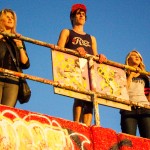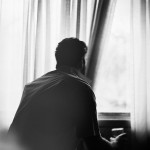
 1. What sparked your interest in photography, and when did you know you would pursue being an artist?
1. What sparked your interest in photography, and when did you know you would pursue being an artist?
The answer to your first question is more of a confession than anything else. From April of 2007 to May of 2012, I only went outside twice – the first time to visit my dying grandmother in the nursing home and the second, to attend her funeral. Agoraphobia robbed me of five years of my life, and it would have been more had I not discovered an old 35mm camera, a Minolta X-700, sitting atop a photography book in a closet I was cleaning. Not having a computer or internet access at the time, I managed to teach myself photography by studying The Kodak Book of Practical 35mm Photography. Only problem was, I quickly began running out of things to photograph indoors and knew I had to either quit photography or start tackling my agoraphobia head on.
It was an extremely warm afternoon in late May of 2012 when I looked out the window and noticed running water coming from a garden hose nearby. I loaded a roll of Fuji Superia 400 into the camera, held my breath, and walked outside to photograph it. It took my eyes a few minutes to adjust to the sunlight, but once they did, I snapped the picture and quickly ran back inside. As silly as this sounds, making that picture was one of the biggest accomplishments of my life. I would build on that act of courage, going outside more and more each day. Eventually I started getting my rolls of film developed at Walgreens whenever I had some spare change. My passion for photography created a positive snowball effect that’s still going to this day. So, to answer your question: what sparked my interest in photography? The will to live.
The answer to the second part of your question might sound strange, but I didn’t think of photography as art, at least not in the beginning. (Even to this day I feel as though photography is a clumsy artistic medium.) However, I knew I wanted to pursue photography as an occupation in July of 2013 once I caught myself thinking about photography almost every waking minute, bringing my camera with me everywhere I went, and having strangers e-mail me through Flickr asking to purchase prints of my work. I’d considered myself a failure for most of my adult life, but photography was now affording me the opportunity to feel like I could be proud and fail with my head held high.
2. What other artists and art forms have influenced you and your work?
I’m a firm believer that an artist’s imagination is heavily influenced by the visual and aural experiences accumulated over his or her lifetime. In my case, television and motion pictures, especially from the late ’70s and early ’80s, heavily influence my style of photography whether I’m conscious of it or not. As I’ve gotten older, however, my interests have expanded exponentially to include many different artists and mediums.
 In regards to photography, my biggest influences are Garry Winogrand, Weegee, Vivian Maier, Robert Capa, Richard Avedon, Robert Frank, Walker Evans, Bruce Davidson, and W. Eugene Smith, to name a few. As for painters, I’m torn on how to answer this because as much as I love the Italian Renaissance (and the work of Titian), my heart lies with Impressionism and Romanticism, specifically the works of
In regards to photography, my biggest influences are Garry Winogrand, Weegee, Vivian Maier, Robert Capa, Richard Avedon, Robert Frank, Walker Evans, Bruce Davidson, and W. Eugene Smith, to name a few. As for painters, I’m torn on how to answer this because as much as I love the Italian Renaissance (and the work of Titian), my heart lies with Impressionism and Romanticism, specifically the works of
Eugene Delacroix, Thomas Cole, Claude Monet, Pierre-Auguste Renoir, and Edgar Degas.
Though Romanticism and Impressionism are constant sources of inspiration, Pop Art has had just as big of an impact on my aesthetic, especially as of late. Robert Rauschenberg, Jasper Johns, Roy Lichtenstein, Dieter Roth, Eduardo Paolozzi, and Edward Ruscha are the first names that come to mind when I think of Pop Art icons who’ve inspired some of my latest fine art photographs, as well as sparked my interest in learning screen-printing.
3. Can you describe your current artistic process, habits, techniques you have formed?
My artistic process, as it pertains to street photography, is pretty simple. I walk around Chicago with the intention of being as observant and unobtrusive as possible. At 6’5, it’s hard to be inconspicuous, but I do my best to go unnoticed so as to capture truly unique, candid moments. Sometimes I feel like more of a cultural anthropologist than a street photographer, but my main objective has always been finding beauty in the monotony of day-to-day life.
As for habits, I do have a few. I always wear a white Marquette baseball cap and earphones when I’m out making photographs. The hat serves as both a good-luck charm and a way for locals to familiarize themselves with me. Instead of people thinking, “What’s that creep doing taking our picture?!,” I want them to see me and go, “Oh, it’s just Charlie. He’s a local photographer who means well.”
 I have a few photographic techniques, sure. Oftentimes I’ll find an aesthetically pleasing background and wait for someone or something interesting to walk into frame. Other times I’ll fumble around with the camera as if I’m beginner or wear kitschy clothing to mimick the appearance of a tourist. Most times, though, I just try to make the picture as quickly as possible before anyone knows what happened.
I have a few photographic techniques, sure. Oftentimes I’ll find an aesthetically pleasing background and wait for someone or something interesting to walk into frame. Other times I’ll fumble around with the camera as if I’m beginner or wear kitschy clothing to mimick the appearance of a tourist. Most times, though, I just try to make the picture as quickly as possible before anyone knows what happened.
Lot of street photographers keep their camera at waist level (otherwise known as shooting from the hip) in attempt to be sneaky, but I’m strongly opposed to this method because it emphasizes content over form. You’re responsible for everything that’s in frame, and if you’re not looking through the viewfinder, how do you really know what you’re making?
My biggest pet peeve are street photographers who insist on using telephoto lenses. In my opinion, it’s a cowardly way of producing voyeuristic images. You need to be a part of the scene if you’re going to capture it accurately. It doesn’t bother me when people catch me making their photograph. I’m not afraid of conflict, however, I try to avoid it as much as possible by smiling and giving a slight nod or gesture of thanks. My smile acts like a wrecking ball in that it tears down those digital walls of isolation we’ve grown accustomed to in this 21st century. When people do confront me, I always explain myself and offer to send them copies of any photographs they’re in. So far I haven’t had any complaints, and with the exception of one extremely dangerous situation I found myself in last summer, I’ve yet to really upset anyone.
4. Is storytelling important in your photography?
Storytelling is important to my photography if I’m working on a documentary project or human interest piece, but most of the time, no. The image itself should tell a story. I feel as though too many photographers try to explain their photographs instead of allowing the viewer to interpret it for themselves. As condescending as this may sound, some viewers are more adroit then others and oftentimes an explanation is necessary for those less artistically-inclined.
5. What are some of your favorite books, poems, authors?
There are three things I don’t publicly discuss in order to avoid conflictand/or sounding ignorant: 1. Politics. 2. Religion. 3. Books. But, since this is an interview for Literary Orphans, I feel obliged to answer. We’ll be here forever if I get going on books, so in the interest of brevity, I’ll stick to poetry – the dagger to books’ long sword. While I deeply, deeply enjoy the works of Oscar Wilde, Walt Whitman, Langston Hughes, Dylan Thomas, William Butler Yeats, Alexander Pushkin, and Lord Byron, Rudyard Kipling’s “If” is the only poem that’s managed to simultaneously move me to tears and strengthen my resolve.
6. Can you put into words the way you have evolved over time as a photographer?
Not having the means to procure all the photographic equipment I need has severely stunted my growth as a professional. That being said, my style and technique never stop evolving. Learning to shoot film before digital was a blessing in disguise. Shooting film forced me to slow down and carefully compose each shot, whereas as soon as I went digital , I became less of a tactician and more of a “spray and pray” photographer. Took me awhile to get out of that habit, but once I did, my keeper rate skyrocketed.
After thousands of hours of studying photography and going out and shooting, it’s all second nature to me now. I no longer have to stop and think about “how” to photograph something, I just do it. Learning my craft backward and forward has allowed me to really explore the limits of my creativity and adjust to any logistical or lighting problems thrown my way. As knowledgeable and experienced as I am, it’s exciting to know I’ve barely scratched the surface of my true potential.
7. Where do you turn for motivation and new sources of inspiration?
Inspiration always seems to come from the most unexpected of places. Oftentimes I’ll be watching a movie or listening to music and an idea pops into my head which I then record on my iPhone’s notepad app to review at a later time. Street photography, however, is completely unscripted. You could walk around with the intention of photographing one thing and come back with something entirely different (or nothing at all) at the end of the day. Though I don’t shoot weddings anymore, when I did, getting to know the couple beforehand helped inspire me to create unique photographs specifically for them.
Motivation is another matter altogether. While I do get discouraged from time to time, I always seem to bounce back rather quickly because I know how fleeting life can be. If I’m not constantly researching new photographic techniques or getting out there and making new photographs, someone else is. There’ll always be photographers with better equipment and more resources at their disposal, but I’ll be damned if anyone is going to outwork me.
8. Discuss the role of community and gallery showings, etc to your growth as an artist.
Exhibiting my work through gallery showings is obscenely important to my growth as a photographer. Plus, gallery shows have the added benefit of stimulating the local economy and fostering a sense of community. I’m extremely new to working with photographic art galleries, but I’ve quickly learned not all galleries (and their owners) are the same. I was extremely flattered when a couple galleries approached me, but after doing some research on them, I knew we wouldn’t be a right fit for each other. I’ve also learned recently that an exhibition can be a huge financial drain and the cost sometimes isn’t worth the reward. One gallery in particular wanted me to be a participant in a high-end presentation group show, but it was beyond my means and our relationship ended on a disappointing note.
It’s been unbelievably difficult, especially in Chicago, to find a gallery owner willing to invest heavily in a newcomer like myself. In fairness to them, I am a risky investment because my website showcases various genres of photography. A photographer interested in making a name for themselves is supposed to stick to two genres of photography, at most. Showcasing a tertiary genre of work, as well as using different cameras and lenses, only serves to dilute one’s brand. As much as I’d like to keep my website focused on street photography and fine art, landscape and cityscape prints are my best sellers.
I spent months trying to apprentice under various well-known photographers in order to refine my work and give it some polish, but I got tired of waiting for people to call me back and decided to just go it alone. Hasn’t been easy, but something will eventually give. As soon as I save up enough to buy the equipment I need and acquire a little more darkroom experience, I know I can be a bellwether in this industry. I’m not interested in money or fame; I’m interested in producing photographic art that emotionally and intellectual knocks people on their collective butts.
9. What do you think is more important for your craft: passion, dedication, or raw talent, and can you elaborate on why?
Dedication, hands down. Professional photography is a marathon, not a sprint. It’s the easiest art form to become proficient in, but the most difficult in terms of finding a unique style all your own. Running a photography business is completely different than “being a photographer.” Disappointment will almost certainly insue when you work extremely hard with the hopes of getting a certain job and then end up with another. Too often the dream of “being a professional photographer” leads to becoming a business owner and the “dream job” of making photographic art for a living has now turned into the “business owner” job which may not be as enjoyable as the original job you had hoped for. This is why when people ask me how to break into professional photography I say, “Do you love photography? If so, don’t make it your profession.” (My next piece of advice on how to quickly break into professional photography is “be wealthy.”)
10. What is a project, or theme you are currently working on, or something that is currently taking your attention, that you are aiming to explore in your work?
I’m currently working on a multitude of different projects in addition to my contractual work. Documenting gang violence in Chicago is probably my most ambitious project, but I’m not sure how much longer it’ll last due to the recent surge in violence. My goal at the outset of the project was to raise social awareness and bring about social reform, but I’m starting to sense that gang members actually enjoy their dangerous lifestyles. I’m mostly worried my presence as a photographer only serves to enable bad behavior. I’ve got some serious soul-searching to do regarding whether or not I want to keep pursuing this project and to what ends.
Some other projects I’m working on are a photojournalistic series focused on the strength of the human spirit and a mixed-media series that includes combining my paintings with my fine art prints. I’ve also been working on creating a coffee table book featuring my images of Rockford, Il., but that’s at least another year or two away. I rely on print sales and money made from contractual work to help fund my personal projects, and unless I receive one of the grants I’ve applied for, it might be awhile before many of these are finished. (Bills before thrills, unfortunately.)